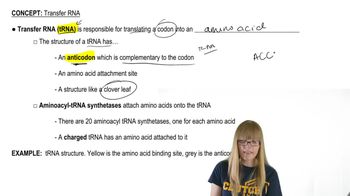How many different proteins, each with a unique amino acid sequence, can be constructed that have a length of five amino acids?
Table of contents
- 1. Introduction to Genetics51m
- 2. Mendel's Laws of Inheritance3h 37m
- 3. Extensions to Mendelian Inheritance2h 41m
- 4. Genetic Mapping and Linkage2h 28m
- 5. Genetics of Bacteria and Viruses1h 21m
- 6. Chromosomal Variation1h 48m
- 7. DNA and Chromosome Structure56m
- 8. DNA Replication1h 10m
- 9. Mitosis and Meiosis1h 34m
- 10. Transcription1h 0m
- 11. Translation58m
- 12. Gene Regulation in Prokaryotes1h 19m
- 13. Gene Regulation in Eukaryotes44m
- 14. Genetic Control of Development44m
- 15. Genomes and Genomics1h 50m
- 16. Transposable Elements47m
- 17. Mutation, Repair, and Recombination1h 6m
- 18. Molecular Genetic Tools19m
- 19. Cancer Genetics29m
- 20. Quantitative Genetics1h 26m
- 21. Population Genetics50m
- 22. Evolutionary Genetics29m
11. Translation
The Genetic Code
Problem 13b
Textbook Question
Third-base wobble allows some tRNAs to recognize more than one mRNA codon. Based on this chapter's discussion of wobble, what is the minimal number of tRNA molecules necessary to recognize the following amino acids?
Arginine
 Verified step by step guidance
Verified step by step guidance1
Understand the concept of wobble: Wobble refers to the flexibility in base pairing at the third position of the codon, allowing a single tRNA to recognize multiple codons. This is due to non-standard base pairing rules at this position.
Identify the codons for arginine: Arginine is encoded by six codons: CGU, CGC, CGA, CGG, AGA, and AGG. These codons are grouped based on their similarities in the first two positions.
Group the codons based on wobble rules: The first four codons (CGU, CGC, CGA, CGG) share the same first two bases (C and G), while the last two codons (AGA and AGG) share the first two bases (A and G). This grouping helps determine how many tRNAs are needed.
Determine the minimal number of tRNAs: For the first group (CGU, CGC, CGA, CGG), a single tRNA with an anticodon complementary to CGN (where N represents any base) can recognize all four codons due to wobble. For the second group (AGA and AGG), another tRNA with an anticodon complementary to AGN can recognize both codons.
Conclude the solution: Based on wobble rules, the minimal number of tRNA molecules necessary to recognize all six codons for arginine is two.
 Verified video answer for a similar problem:
Verified video answer for a similar problem:This video solution was recommended by our tutors as helpful for the problem above
Video duration:
1mPlay a video:
Was this helpful?
Key Concepts
Here are the essential concepts you must grasp in order to answer the question correctly.
Wobble Hypothesis
The wobble hypothesis explains how the third position of a codon can tolerate mismatches between the codon in mRNA and the corresponding anticodon in tRNA. This flexibility allows a single tRNA to pair with multiple codons that code for the same amino acid, thereby reducing the total number of tRNA molecules required for protein synthesis.
Recommended video:
Guided course

Translation:Wobble Hypothesis
Codons and Amino Acids
Codons are sequences of three nucleotides in mRNA that specify particular amino acids during protein synthesis. Each amino acid can be encoded by one or more codons, which is crucial for understanding how many tRNA molecules are needed to translate a given set of codons into proteins.
Recommended video:
tRNA Molecules
Transfer RNA (tRNA) molecules are responsible for bringing the appropriate amino acids to the ribosome during translation. Each tRNA has a specific anticodon that pairs with a corresponding codon on the mRNA, and due to the wobble effect, fewer tRNA types can recognize multiple codons for the same amino acid, such as arginine.
Recommended video:
Related Videos
Related Practice
Textbook Question
949
views



